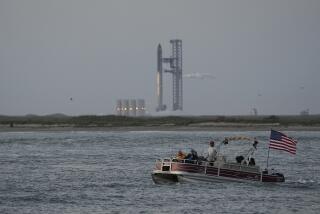Blazing Mir Plunges Safely Into S. Pacific
KOROLYOV, Russia — In a nail-biting operation, Russia’s spaceflight controllers pushed the Mir space station into its final fiery descent Thursday night Pacific time, making it the largest man-made object ever brought out of orbit.
The controllers allowed themselves a moment of triumph as the station broke up over the target area in the South Pacific east of New Zealand. It had completed 86,331 orbits.
“The orbital complex, Mir, has fulfilled its triumphal life mission,” a flight control official announced about 10 p.m., the time of impact.
Yuri Koptev, head of the Russian Space Agency, extolled a “model performance” by the country’s specialists.
“They have not made a single mistake in any detail. They were precise to the millimeter,” he said with pride.
In the island nation of Fiji, witnesses described the Mir’s end.
“We saw five or six fragments with a huge smoke trail that lasted for 10 to 15 seconds, followed some time later by a couple of sonic booms,” said Reuters photographer Mark Baker. “It was above our heads, below the clouds. It was a once-in-a-lifetime experience.”
At 9:07 p.m. PST, Russian mission control fired all engines on the Progress M1-5 rocket docked with Mir, the final move to force the station down to Earth.
With U.S. tracking stations confirming that the station was on its planned trajectory, Russian ballistics experts announced that the fragments of Mir would splash into the Pacific in an area about 40 degrees south latitude and 160 degrees west longitude.
“The world saw today that Russia is capable of not only building space objects but also of managing them properly. It’s yet more proof that Russia has always been and will remain a space power,” said Koptev.
About 8:48 p.m., Russian mission control had announced that the station had reached the outer layers of the atmosphere, about 60 miles above Earth.
“At this altitude we expect the aerials to come off,” a mission control official announced.
Earlier, before the station left the zone of contact for Russian tracking stations, officials announced the station’s systems were operating normally on its final orbit.
As the downing of the station began, the atmosphere at mission control in Korolyov, just north of Moscow, was tense and businesslike.
“This is not a funeral. It’s just the end of our work,” said Mikhail L. Pronin, the Mir chief engineer who worked on the space station throughout its 15 years of operation. “Every technical device has a beginning of its life and an end.”
The expulsions of Russian diplomats by the United States on Wednesday cast a pall at the space center as controllers worked to bring Mir down.
“I don’t have grounds to link the de-orbiting of Mir with the expulsion of the Russian diplomats, but the background is definitely unpleasant,” said Koptev.
There was nostalgia, sorrow and anger among cosmonauts present to say farewell to Mir.
Alexander Lazutkin served on Mir in 1997 during its most troubled moments, when a Progress cargo ship collided with Mir, puncturing the Spektr module and endangering the three crew members. He expressed deep bitterness at Mir’s loss, claiming that the government could have found the funds to keep the station aloft.
“I haven’t drunk to Mir’s memory yet, but we will drink today, that’s for sure,” he said.
Lazutkin said March 23 would always be a somber day for Russian cosmonauts.
“The entire country has lost a home and a place of its own in space, and this feeling dwarfs the personal loss,” he said. “If the government had managed to find the money to finance Mir three months--even one month--ago, we wouldn’t have had to sink it today.”
He echoed the view of many in Russia’s space community that there were no technical problems that could not have been resolved.
But Koptev said, “It’s our duty to sacrifice our emotions and our nostalgic feelings for the sake of ensuring safety.”
Russian experts had been planning the controlled descent for months, including contingencies for on-board power blackouts or computer failures.
But space officials here admitted in advance that there was a 2% chance the station would spin wildly out of control. Russia took out a $200-million insurance package to cover any damage outside the country.
The government’s decision in November to kill Mir because of mechanical and financial woes spread gloom in the Russian space community, which is left without a major research program of its own.
The operation triggered fear and even resentment in the countries near the target area and fever among space junk collectors eager for a souvenir. Japanese authorities warned residents to stay indoors during the station’s final descent, and Australia was ready with an emergency plan.
But a fleet of fishing boats in the debris zone did not leave. “The fish are biting in that area, and it has been a tough year for them so far, so they are staying,” Wayne Heikkila, general manager of the Western Fishboat Owners Assn., told Associated Press.
Listing in stormy seas, the crews of 27 South Pacific albacore trollers spent a tense moment Thursday night in the Mir’s impact zone.
Most of the 200 fishermen from ports such as San Pedro and San Diego banked on the minute probability of their 70-foot boats being hit by a molten chunk of debris.
Ultimately, no one was harmed, and no one saw anything in the skies but low clouds and occasional stars.
In recent weeks, Mir had been gradually sinking, reaching an orbit 132 miles high, and without intervention it was likely to have crashed to Earth uncontrolled later this month.
Many Russians were disturbed at the loss of Mir, with a recent poll indicating that only about a quarter of respondents supported the decision to dump it. Some advocated simply pushing the station higher into orbit in the hope that Russia could find funds later to restore operations on the craft.
Perishing along with Mir were the Progress craft guiding the station’s fall and more than 13 tons of scientific equipment worth an estimated $80 million, including telescopes, spectrometers and radiometers.
Perhaps the most sentimental item to go down with Mir was a photograph that had been in orbit nearly 20 years: a framed portrait of Russia’s greatest space hero, Yuri Gagarin, the first man in orbit. The picture had been transferred to Mir from its predecessor, the Salyut-7 space station.
Among the most eccentric items was an electric guitar--a contribution from an American crew member. In addition, there was all the clutter of the inhabitants’ domestic lives: exercise equipment; a 100-volume library, including copies of the Bible and the Koran; a video collection; and audiocassettes.
As the station plummeted, its protruding solar panels, antennas and aluminum thermal radiators probably were the first parts to be stripped off because of the friction. Burning up at temperatures of about 3,000 degrees, the spacecraft broke apart and fell in a spectacular shower of red-hot metal.
Most of the station was incinerated. Russian scientists earlier predicted that 1,500 pieces, weighing a total of up to 27 tons, would hit the planet in a 124-mile-wide swath stretching 3,728 miles across a remote area of the Pacific.
They also predicted that the largest piece could weigh as much as 1,500 pounds. But space scientists in Korolyov said it was difficult to estimate the speed at which the pieces would hit Earth.
Hours before the final plunge, Vladimir Solovyov, Mir flight control director, said the station was obeying commands as hoped.
“We are really hoping that Mir’s rather successful 15-year history will not be smeared by this,” he said. “We would like to put the station down in the desired place.”
In January, the Progress cargo ship, carrying nearly 2 tons of fuel, docked with Mir in preparation for the descent. The two craft were allowed to tumble in orbit to conserve Progress’ fuel for the descent.
The first stage of the operation to bring down Mir began March 12 when flight controllers rebooted the on-board computer.
Late Wednesday Pacific time, flight controllers had fired Mir’s engines to stop the station’s tumbling and reorient it to the sun to charge its solar batteries.
At 4:32 p.m. PST Thursday, controllers fired the eight small correcting engines on the Progress ship for about 20 minutes, slowing Mir so it was drawn closer to Earth.
At 5 p.m., Nikolai Ivanov, deputy chief of the control center, announced that the burn had gone according to plan.
About 6 p.m., on the following orbit, the eight engines were fired a second time for more than 20 minutes.
In a powerful thrust at 9:07 p.m., all nine Progress engines, including the main engine, were fired for about 23 minutes to push Mir down.
(BEGIN TEXT OF INFOBOX / INFOGRAPHIC)
The Final Path of Mir
The Mir space station, a relic of the once-proud Russian space program, was brought down in a fiery but controlled plunge into the South Pacific between Australia and Chile.
*
4:32 p.m. and 6 p.m. PST:
* (137 to 132 miles above Earth) Mission Control fires the engines of an attached Progress cargo ship twice during consecutive orbits.
*
9:07 p.m. PST:
* The Progress engines fire again to send the station plunging.
*
9:30-10:30 p.m. PST:
* (90 to 50 miles above Earth) The breakup begins. Loose objects such as solar panels and extended radars break off, and the station begins to burn up.
* (25 miles and below) Pieces continue to cool during reentry, and those that survive make it to Earth’s surface.
*
10:30 p.m. PST:
* Impact.
Sources: Associated Press, Space.com
More to Read
Sign up for Essential California
The most important California stories and recommendations in your inbox every morning.
You may occasionally receive promotional content from the Los Angeles Times.










